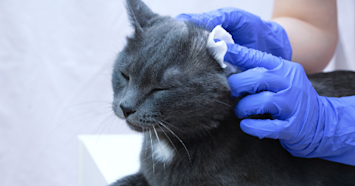
Cats are traditionally pretty good at grooming themselves, but there is one spot they simply can’t reach. You guessed it, the ears! Sometimes your cat may need a little bit of help to remove the buildup of wax or debris inside.
Do I Need to Clean My Cat’s Ears?
Ear cleaning is not always needed in cats. Their ear anatomy does not have much variation in the shape or size of the pinna, or earflap, among different breeds. The ears are relatively short and have a straighter canal than a dog. This shape allows them to shake out any dirt or debris that may collect inside the ears.
When Should I Clean My Cat’s Ears?
Only clean your cat’s ears if a small to moderate amount of debris or discharge can be seen in the pinna and the ear drum is intact. Clean the ears only as needed, such as once every 2-3 months. Over-cleaning can lead to irritation. Healthy cats generally do not need routine ear cleaning.
What Supplies Do I Need?
A good-quality feline ear cleaner solution
Cotton balls or gauze
Treats
Optional:
A bath towel or small blanket, if necessary, to wrap up your pet
Dry washcloth to clean the face afterwards
Caution: Things to Know Before Attempting to Clean Your Cat’s Ears
Avoid using hydrogen peroxide or alcohol as they can cause discomfort
Never use a cotton swab (Q-tip) as they can damage the ear canal and/or push debris deeper into the ear canal. There is also an increased risk of rupturing the ear drum if the swab and/or debris is pushed too deep.
Only clean what you can see; this is what the ear cleaner is intended to clean
Feline Ear Cleaning Technique
Sit in a comfortable position with your cat in your lap. It is best for your cat to be relaxed. You may wrap your cat’s body (with the head out) in a towel or small blanket, if necessary, to help minimize discomfort. Stop immediately if your pet is in pain or distressed.
Praise your cat with treats to reward calm behavior throughout the ear cleaning.
Saturate a cotton ball with the ear cleaner solution and warm in your hand for 15-30 seconds. This will warm the solution as well as avoid cross contamination between the tip of the ear cleaner bottle and the ear. This may also be less scary for the cat than pouring cold cleaner into the ear directly.
Fold back the ear flap, or pinna, and gently place the saturated cotton ball into ear.
Gently massage the base of the ear while squishing the saturated cotton ball to release the solution into the ear canal.
Continue the massaging motion for 30 seconds to loosen the debris. You should hear a squishing sound to indicate you are properly cleaning the ear canal. If you do not hear a squishing sound, you are either not massaging the ear canal or did not use enough ear cleaner.
Remove the cotton ball.
Allow your cat to shake their head and expel the remaining ear cleaner, debris, and ear wax.
Repeat the process on the other ear.
Use a dry cotton ball or gauze to gently wipe excess debris out of the pinna
You may use a dry washcloth to gently clean your cat’s face when finished.
If your veterinarian has prescribed a medication for an ear infection, you may apply the medication after cleaning and drying the ears first.
If your cat appears in pain or in distress while cleaning, stop and consult your veterinarian. Your veterinarian can relieve pain and reduce anxiety with prescription medications. If warranted, full sedation may be needed for further evaluation of the ear canal and/or a deep ear flush.
Is there any risk to cleaning my cat’s ears?
It is possible to damage the ear canal and/or ear drum if you clean the ears improperly. Cats have a higher risk of ototoxicity and neurological signs than dogs. Cleaning a cat’s ears must be less aggressive than in dogs for these reasons. If you are at all uncomfortable or uncertain how to properly clean your cat’s ears, please visit your local veterinarian. They will have skilled staff who can teach you the proper techniques to minimize risks.